Distributed power architectures (DPAs) are many and varied. DPAs, including the dynamic bus architecture and the intermediate bus architecture, are evolving as a result of new power demands from FPGAs, CPUs, GPUs, ASICs. And the concept of a DPA has extended into distributed power control architectures (DPCAs) being developed for electric vehicle charging stations, renewable energy generation, and other large-scale applications.
Compared with an ac distribution system, dc distribution can be more efficient and less expensive to install. DC distribution facilitates the integration of renewable energy and storage systems. In a typical DPA used to power electronic equipment, there is a one-to-one correspondence between the local power converters and loads. In addition, there are a variety of specialized DPAs used in industrial, transportation, renewable energy, and other application areas.

DPAs first appeared in the late 1980s for telecommunications central offices. Those original DPAs were needed as solid-state electronics replaced relays. They were based on 48Vdc power distribution with one isolated dc/dc converter for each circuit board in the facility. The next iteration of the DPA, the intermediate bus architecture (IBA), appeared in the 1990s. As the name implies, the IBA has an intermediate distribution bus voltage, usually 12Vdc, between the 48Vdc main power bus and local non-isolated dc/dc converters called point-of-load (PoL) regulators.
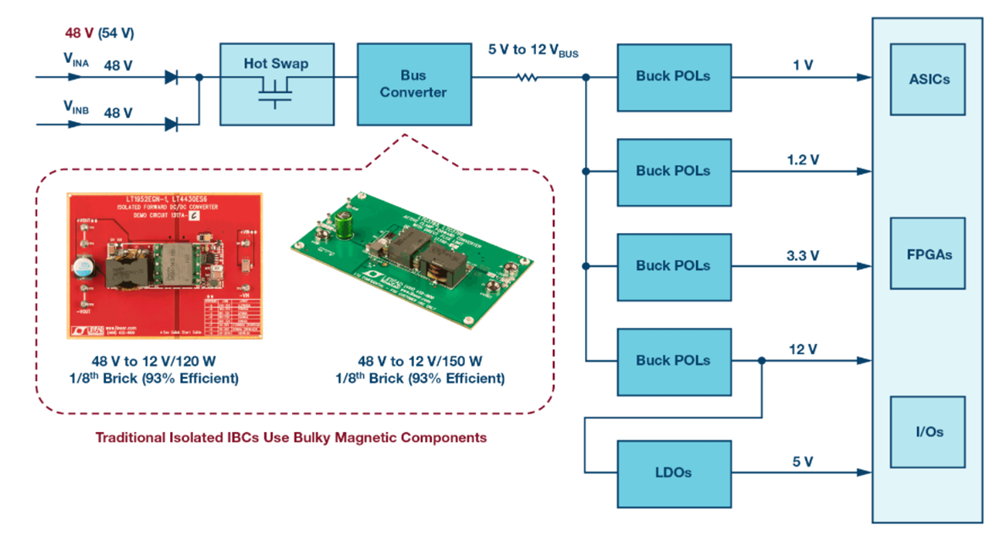
The IBA was developed to address the changing needs of the local loads being powered. In the 1980s, the loads usually needed to be powered with 5Vdc, which could be addressed using isolated 48V-to-5V converters. As 3.3V became more common, the isolated converters could still be used. Still, at lower voltages such as 2.5V and below that appeared in the 1990s, it was no longer efficient to convert directly from 48V to the lower voltages needed by advanced digital ICs. By converting the 48V in two stages, efficiency was maintained and even improved. Also, during the 1990s, DPAs began to be used in data centers and telecommunications central offices.
DPAs have continued to evolve and expand. Today, they are found in portable devices as well as large installations. In portable devices, for example, battery voltages such as 14.4V are distributed and converted down as needed for specific loads. During the 2000s, the dynamic bus architecture (DBA) concept where the intermediate bus voltage changes as the power needs of the facility change. By distributing a higher intermediate voltage (such as 12V) to deliver more power and a lower intermediate voltage (such as 8V) during times of lower activity, end-to-end power distribution efficiency was improved.
IBAs are implemented with both regulated and unregulated intermediate bus voltages. When used in an unregulated architecture, the bus converter is called a fixed-ratio converter, and the unregulated output voltage changes with changes in the input voltage. Unregulated fixed-ratio converters can provide higher efficiencies, especially in higher-power systems. And unregulated converters tend to be lower in cost. Compared with regulated bus converters, unregulated converters typically operate over a more restricted input voltage range to ensure proper operation of the PoLs. The selection between regulated and unregulated IBAs is based on a series of specific operating tradeoffs.
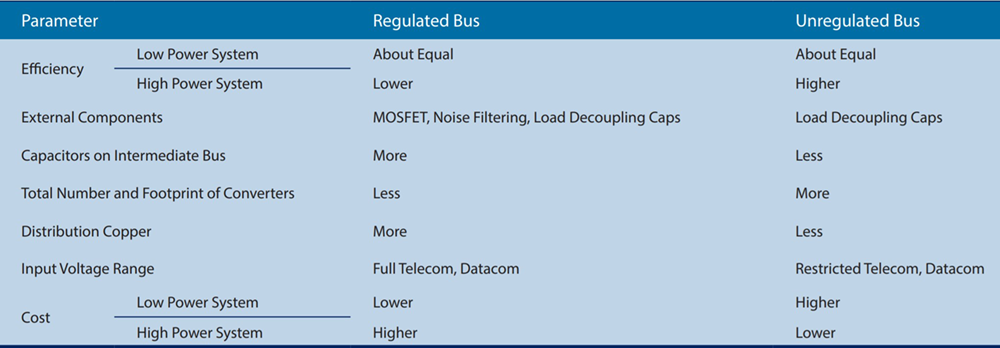
Adaptive voltage scaling bus
The PMBus communications standard is used in various power conversion applications from ac/dc power supplies to PoL converters in DPAs. The Adaptive Voltage Scaling Bus (AVSBus) is one of the newest parts of the PMBus specifications. Using the AVSBus specification, complex logic devices, like processors and large FPGAs, can directly control their supply voltages as fast as possible, maximizing overall operating efficiency.
While the standard I2C bus upon which PMBus is based is limited to 5MHz operation, AVSBus can operate at speeds up to 50 MHz and is designed to minimize communication delay and maximize energy savings. For example, when a logic device wants to enter an energy-saving mode, like a hibernation or sleep state, it generally lowers its supply voltage to a minimum value. The faster the voltage can be changed from the normal or high-performance operating value to the energy-saving value. The more energy can be saved. Conversely, when a logic device wants to return to normal or high-performance operation, it is important that the voltage be increased to the new operating voltage as quickly as possible to maximize performance.

48Vdc to 6Vdc converters for data centers
Another recent DPA development is the appearance of 48V-to-6V intermediate bus converters (IBCs). A 6Vdc intermediate power bus enables the use of a high-frequency power stage that is small enough to be placed very close to the load, reducing power distribution losses by 4x compared with the use of a 12Vdc intermediate bus voltage.
The first 48V-to-6V IBC uses an LLC topology and GaN FETs to achieve an overall efficiency of 97%. It is designed for use in unregulated IBAs and operates as a fixed ratio 10:1 non-isolated dc/dc converter with an input range of 40V to 60V. Rated for 300W, it measures 27 mm x 18 mm x 6 mm and is targeted for use in high-density computing and data centers, artificial intelligence, machine learning, and multi-user gaming.

One of the most recent DPA developments has been the emergence of 380Vdc as a standard distribution bus voltage, replacing 48Vdc and driving higher distribution efficiencies, especially in large installations. Compared with 48Vdc distribution, much higher power levels can be efficiently distributed using 380Vdc. The European Telecommunications Standards Institute (ETSI) and others have developed 380Vdc distribution standards for telecommunications central offices and data centers. And the EMerge Alliance has developed a series of 380Vdc distribution standards to enable the development of DC and hybrid AC and DC microgrids and power systems in various applications from renewable energy installations to industrial and ITC facilities.
Fast serial interface and DPCAs
Distributed power control architectures (DPCAs) are an emerging area in DPAs. DPCAs use high-speed MCUs together with flexible control peripherals and a new communication module called the fast serial interface (FSI). DPCAs are designed to support system-level solutions in PV string inverters, off-board electric vehicle chargers, manufacturing, industrial systems, fuel cells, and other large-scale distributed dc/dc or ac/dc applications.
The new FSI module is key to DPCA implementations. It provides reliable high-speed communication across isolation devices with higher speed, lower latency, noise-tolerant signaling, and build-in error detection and correction. It is built for speed but not for the transfer of large data transfers. Designed to communicate bytes of data transfer between control loops in a DCPA, the FSI module includes embedded data robustness checks, data-link integrity checks, skew compensation, and integration with control peripherals. It is intended to support the implementation of DPCA systems and enables high-speed, robust communication of limited amounts of data in a DPA.
For example, a DCPA can be applied to a conventional DPA using a central isolated ac/dc power supply and distributed non-isolated dc/dc converters. Each of the ac/dc and dc/dc power converters is controlled by an MCU (C2000). All the MCUs are connected through their respective FSI ports, enabling coordinated operation, increased end-to-end efficiency and higher reliability, and better availability.
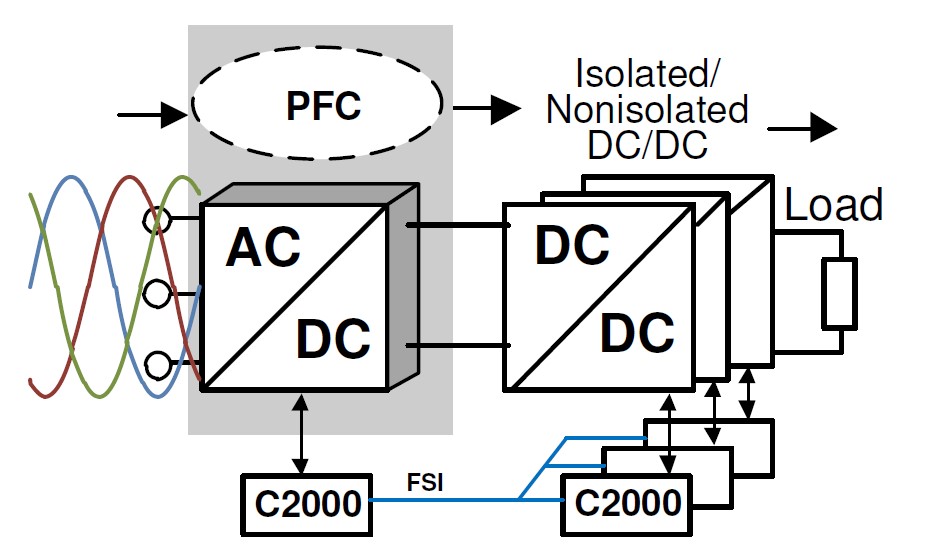
A similar DPA approach can be used in solar generation systems where the ac/dc power supply is replaced by a dc/ac inverter. The distributed dc/dc converters are used for maximum power point tracking (MPPT) of a series of PV strings. In addition, to optimize the PV system’s power production, a DPCA can be used to coordinate the operation of an attached energy storage system (ESS). This is a more complex control system compared with the simple DPA illustrated above. In this case, the grid-tied inverter and the dc/dc converters for the ESS are bi-directional, and the dc/dc converters for PV string MPPT require another complex control algorithm. Managing this system for maximum energy production in real-time can benefit from FSI communications and a DPCA.
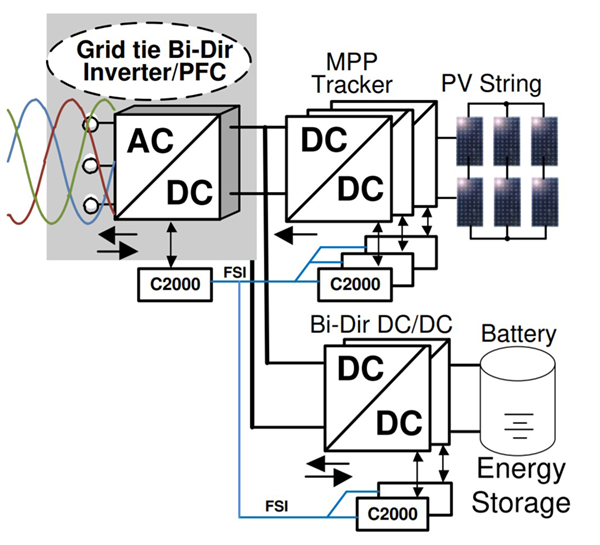
Summary
DPAs have been around since the 1980s. During that time, they have evolved considerably and today benefit from the use of advanced power conversion technologies such as GaN power devices and advanced control topologies such as the DPCA. The use of DPAs has expanded from telecommunications central offices to data centers and even portable devices. And the use of DPAs is expanding into new application areas, including renewable energy generation, energy storage, electric vehicle charging, and various industrial uses.
References
48V data center solutions, Monolithic Power Systems
72 V Hybrid DC-to-DC Converter Reduces Intermediate Bus Converter Size by up to 50%, Analog Devices
Adaptive Voltage Scaling Technology, Texas Instruments
An Overview of Direct Current Distribution System Architectures & Benefits, MDPI
EMerge Alliance
Distributed Power Control Architecture With Multiple MCUs Over FSI, Texas Instruments
PMBus™ V1.3 with AVS, SMIF, Inc.
Selection of Architecture for Systems Using Bus Converters and POL Converters, Flex Power Modules

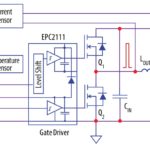
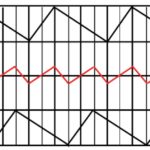
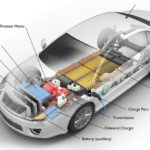
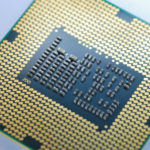


Leave a Reply